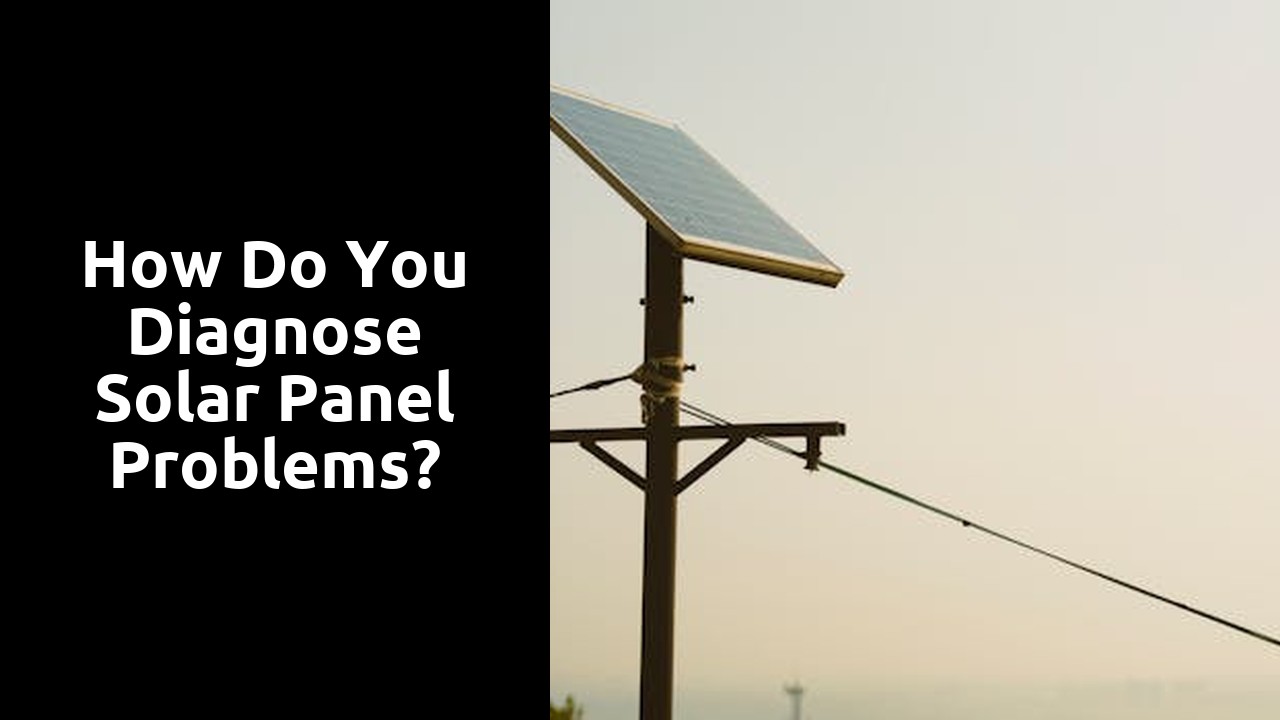How do you diagnose solar panel problems?

Performing an Infrared Scan of Solar Panels
Solar panel system troubleshooting often involves the use of infrared scanning technology to detect any underlying issues. This method allows experts to identify hot spots or malfunctioning cells within the solar panels, which could potentially affect the performance of the entire system. By conducting an infrared scan, technicians can pinpoint specific areas that require further investigation or maintenance to ensure optimal functionality of the solar panel system.
Infrared scans are crucial for diagnosing problems with solar panels as they provide detailed insights into the temperature levels of the panels. Monitoring for overheating or abnormal heat patterns is essential in preventing potential damage to the solar panels and ensuring the longevity of the system. Through the use of infrared technology, technicians can accurately assess the health of the solar panel system and address any issues promptly to maintain efficiency and performance.
Detecting Hot Spots or Malfunctioning Cells
When it comes to identifying issues in solar panels, a crucial aspect is detecting hot spots or malfunctioning cells. These problems can significantly impact the efficiency and overall performance of a solar panel system. Hot spots usually occur due to a mismatch in the cells or shading issues. By conducting regular checks, solar panel owners can pinpoint these potential problem areas and take necessary actions to rectify them promptly. Effective detection of hot spots can prevent further damage to the system and ensure optimal functioning of the solar panels.
In the realm of Solar Panel System Troubleshooting, malfunctioning cells can be a major concern. A malfunctioning cell can impact the power output of the entire solar panel system. These faulty cells can arise from various factors such as manufacturing defects, extreme weather conditions, or ageing. By employing specialised tools like infrared scanners, technicians can identify malfunctioning cells and replace them to maintain the efficiency of the solar panel system. Regular monitoring and swift action are essential in addressing malfunctioning cells to ensure the longevity and effectiveness of the solar panel system.
Checking Solar Inverter Functionality
When diagnosing solar panel problems, checking the functionality of the solar inverter is a crucial step in Solar Panel System Troubleshooting. The solar inverter is responsible for converting the direct current (DC) electricity generated by the solar panels into alternating current (AC) electricity used in your home or sent back to the grid. To ensure the inverter is working as it should, start by checking its display screen for any error messages or alerts indicating issues with the system's operation.
Once you have inspected the display screen of the solar inverter, physically examine the unit for any signs of damage, loose connections, or unusual noises. Additionally, verify that the inverter is receiving an adequate power supply from the solar panels by checking the voltage and current levels. Any deviations from the normal operating parameters could be indicative of an underlying problem that requires further investigation in Solar Panel System Troubleshooting.
Verifying Proper Conversion of DC to AC Power
Verifying Proper Conversion of DC to AC Power in a solar panel system is crucial for ensuring the efficient generation of electricity. To confirm this conversion is occurring accurately, one must first conduct a visual inspection of the solar inverter. Look for any signs of damage or malfunction that may indicate issues with the conversion process. Additionally, it is important to check the inverter display for any error codes or abnormal readings that could point towards improper conversion of DC to AC power.
If visual checks do not reveal any obvious problems, the next step in verifying proper conversion is to monitor the electricity output of the solar panel system. This can be done by examining the power production data on the monitoring system associated with the solar panels. Any significant discrepancies between the expected AC power output and the actual output could indicate a problem with the conversion process. To ensure optimal performance and energy generation, it is essential to address any issues related to DC to AC power conversion promptly as part of Solar Panel System Troubleshooting.
Testing Solar Panel Temperature Levels
When it comes to conducting thorough Solar Panel System Troubleshooting, monitoring temperature levels of the panels is crucial. Excessive heat can indicate a malfunction or inefficiency within the system. By using a handheld thermal camera, you can easily detect any abnormal temperature patterns across the solar panel surface.
Identifying variations in temperature can help pinpoint potential issues, such as shade affecting specific panels or malfunctions in individual cells. Regularly monitoring the temperature levels of your solar panels can aid in early detection of problems, ultimately leading to more efficient maintenance and improved overall performance of the system.
Monitoring for Overheating or Abnormal Heat Patterns
When it comes to the diagnosis of solar panel problems, monitoring for overheating or abnormal heat patterns is a crucial aspect of Solar Panel System Troubleshooting. Excessive heat can indicate underlying issues in the panels or system components, which may lead to reduced efficiency or potential safety hazards. By closely monitoring the temperature levels of the solar panels, technicians can identify anomalies that require further investigation.
Overheating in solar panels can be caused by various factors such as shading, soiling, or faulty wiring. Regularly checking for abnormal heat patterns helps in early detection of these issues, allowing for timely repairs or maintenance. Utilizing thermal imaging technology can provide detailed insights into the temperature distribution across the solar panels, enabling technicians to pinpoint specific areas that require attention. Monitoring for overheating is essential to ensure the optimal performance and longevity of a solar panel system.